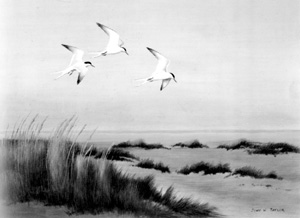 Little
Island, Little Birds ~
Little
Island, Little Birds ~ Little
Island, Little Birds ~
Little
Island, Little Birds ~
What happens when we lose
a couple hundred tiny pieces of
the great Chesapeake Bay jigsaw puzzle?
by Cawnya Hawkin
Illustration courtesy of John Taylor, whose works and story you'll read within an upcoming issue of New Bay Times.
A century ago, when erosion was nothing to worry about, Kent Island quietly calved 40 acres of prime, shorefront real estate from its southern tip. Today, Bodkin Island is a crumbling cork, worn to less than an acre by a hundred years of tropospheric hostilities.
When Bodkin finally sinks, with it go two hundred pieces of the great
Chesapeake Bay jigsaw puzzle: the common terns that have made the tiny island
their summer home since some former generation of terns long ago claimed
it.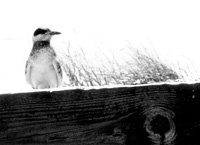
Little as it is, a tern is an inspiring character. At four ounces, the weight of as many rolls of film, a tern's fuselage seems too light for its yardstick-long wing spread. The sharp-looking black cap on its tiny head and the black trailing edges on its wing feathers contrast dramatically with a brilliant white body, giving the tern an air of proud distinction. Elongated tail feathers lend an added measure of class to the tern's look and a swallow-like grace to its flight profile.
Year after year, the terns come back to lessening Bodkin from points as far away as South America, because Bodkin is where they were born. The phenomenon of returning to the summer birthplace is typical of the species, the record being held by a colony in New York that came back 17 seasons in a row.
This time of year the terns are leaving Bodkin, having completed the cycle begun last March as, one by one or in small groups, they arrived on Bodkin to court, mate, nest and be doting parents for 60 days. It takes 30 days to hatch an egg and another 30 before the chick learns to fly.
The tern population on the island, depending on the year, increases to as many as 200 by early summer, so it isn't long into the season before Bodkin becomes a very busy place.
What's left for them is a hundred square feet per tern, which seems more
than adequate, but only if you don't count the other birds that nest there:
about a hundred egrets (snowy, cattle and great), a sprinkling of herons
(little blue and green) and, for the first time in '97, one nesting pair
of gulls.
Herons and egrets have staked out Bodkin's interior, over-decorating a half dozen surviving black cherry trees with their nests or stuffing them into the groundsel bushes. Earlier in the year, their fledglings geedunk through the thick entanglements of yellow nutgrass, trumpet creeper vines, phragmites and more than nine other species of plants that surround the island's inner sanctum like a fortress.
A tern doesn't require as much space or protection for its own nest. Prime real estate is considered a small patch of sand where it can plop down and spin its plump little belly in a circle, leaving a shallow impression for the two or three brown-speckled eggs that will be laid right there in the open. At the height of nesting season, as many as 40 eggs spread over two car-sized patches of sand on the southern side of the island, though nest sites aren't exclusive to those areas.
Lilliputian-sized plots on the western and southwestern sides of Bodkin are overgrown by salt meadow grass (thick clumps of it that mat and cowlick), wild rye, wild lettuce, sheep sorrel and wild bean. Because of the peculiar ways each species of plant competes for space (lots of pushing and shoving), there are created a myriad of cubbyholes and passageways used by parent birds to enshroud their eggs and by the chicks to rest, putter or hide out.
But so much for observations from the periphery. Let's get personal.
Terns in Their Time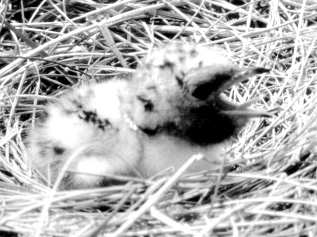
From a confirmed naturalist's point of view, there are several charming behaviors unique to the terns to support the argument that - if the terns disappear with Bodkin - the portrait of the surrounding area will be rendered a few hundred paint strokes less bright. That's because terns are truly colorful characters, ones that have leaf-pressed themselves onto many bird-conscious souls.
Doug Walters, a sea kayaker and self-taught naturalist who has logged many miles around the tri-state area, calls watching terns hunt a favorite pastime:
"I like to watch a tern hover just before the dive, its head bent down, working its wings like a hummingbird. Suddenly, it'll plummet 30 feet straight down and penetrate a foot into the water. Early one quiet morning, at slack tide, I saw a couple dozen of them hovering in one place, dropping out of the sky into the water one after the other, making for a collection of plopping sounds that had the lyrical quality of a song. I was mesmerized," says Walters.
Terns are as adept at parenting as they are at hunting, fearlessly attacking enemies of any size or kind. The freeloading egrets on Bodkin have learned to take advantage of the terns' parental tenacity.
One evening in June, just as a brilliant red sun was about to pull the last bedcover over its head, Ernie Frye dropped anchor off the southern side of Bodkin to do a little night fishing. Terns a hundred strong were lined up on the rock breakwater facing him.
"All of a sudden," he recounts, "from around the side of the island, 13 herring gulls came in low and slow like bombers in formation. Instantly, the terns launched from their perches to attack. Like fighter pilots, they climbed high, and then dive-bombed the gulls from overhead to drive them off. The egrets watched the entire fracas from their nests like a bunch of semi-conscious couch potatoes."
Terns will attack humans if the invisible circle around the nesting site is transgressed. Some have even drawn blood. They fly directly at the trespasser, straight for the eyes, screaming tee-arr-r-r or tut-tut-tut. Then they'll strafe the unlucky soul and quickly regroup for another run
The love spiral is another endearing, if seldom seen, habit of the common tern. Bird watchers Preston Gilmont, a regular visitor to Kent Island, describes it:
"To acquire a mate," Gilmont says, "the male fetches a minnow and presents it to the lady of his choice. If she accepts it, the two of them fly as high as 600 feet and then let go, dropping slowly, turning and passing one another in a single downward spiral."
Romance aside, one of the more mysterious tern behaviors is the phenomenon
called the 'dread.' Every tern in the colony (as many as 200 birds) will
become absolutely quiet for no apparent reason. And that's saying something,
because terns are yappers. Then they'll rise up silently, en masse, and
fly out over the Bay a mile or so. After a few minutes, they'll return as
if nothing had happened. This behavior still confuses the experts, who admit
observing and understanding terns is a very difficult task, since all of
them look alike.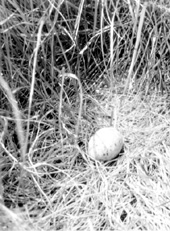
It's easy to see them hunting, warming their eggs, preening or trying to snatch a comrade's fish. One of my favorites, special to the tern because of its extremely long wingspan, is the 'angel arch.' After a lengthy rest, a tern fully extends its wings in a pose that smacks of angel wings arched straight up for takeoff or for balancing on shaky ground.
There are also lots of cat-and-mouse games to watch that are perhaps courtship or territorial kinds of things. But you couldn't follow the path of a particular individual through the course of an entire day.
Tern chicks all look alike, too, and it confounds an amateur like myself to watch parents looking for their own children. Most behaviors in the wild have evolved to facilitate survival of a species, except for tern parents, in which case the rule apparently does not apply.
As soon as a tern chick is strong enough, it wobbles away from the nest for the protection of high grass. On more occasion than one, I've see a parent returning to the island with a fish in its beak, apparently unable to find its chick. They'll hover here and hover there, peering. Sometimes, when they land, they'll discover just in time that they've got the wrong chick and have to snatch back the minnow, climb to hover height and begin the search all over again.
Buying a Bit More Time
On September 5, I watched the last of Bodkin's tern hatchlings leave
the island for its southern over-wintering ground. As it shrunk to the size
of a period under a question mark, I wondered would there be a Bodkin Island
for it to return to next spring?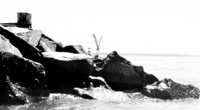
The answer is that what happens to the island is not clear over the long term. In 1996, the Army Corps of Engineers signed up to make Bodkin a spoil site for material dredged from the Kent Narrows channel. The plan was to build up the northern side of the island. The project fell through.
Again in 1997, Bodkin appeared to have been saved. Ducks Unlimited received a marsh grant to repair the breakwater on the north side of Bodkin and backfill with material dredged from a private marina. John Gill, a biologist with the U.S. Fish and Wildlife Service, was directing the project in cooperation.
But it, too, came to nought, when the barge that would have brought the dredged material proved to draw too much water to approach Bodkin Island. Still, Gill hasn't give up hope.
"I sure hope little Bodkin's going to hold on for a few more years. We've been trying to do something for a lot of years, and now it's down to .9 acres. We've got the habitat restoration plan all done; all we need is dredge material and money." Now, Gill's hoping to piggyback Bodkin's restoration on some future, nearby Corps of Engineers' dredging.
Meanwhile, though, a section of bulkhead has failed and "erosion is pretty bad."
Bodkin Island's sinking isn't the species' first close call. During the last century, milliners paid top dollar for tern feathers to supply the demand for plumage in women's hats. Federal legislation stopped the feather pluckers, and tern populations bounced back, but not before most of the colonies on the Eastern Seaboard were nearly wiped out.
A Question of Value
On a typical day, pleasure boaters pass Bodkin, an unattractive place in its own right, without a hint that so many pulses lie hidden beneath the camouflage. Yet Bodkin is a full-fledged terrarium of crickets, dragonflies, tiger beetles, orb-weaving spiders and a dozen other species of crawling and flying insects. Adding an exotic flair are the monarch butterflies that use Bodkin like a buoy in navigating their way south to Mexico every year.
I once watched five monarchs, in predictable intervals, approach from
the northeast. Over Bodkin, they dawdled near the midriffs as if looking
for something lost. Then, remarkably, each picked the same spot from which
to careen off the island in a southerly direction. A quarter mile offshore,
clearly each was tracking the same compass course.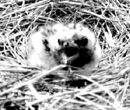
But let's for the moment put a lid on the wonder of bug gibberish and sloppy sentiment. There are tangible, ecological - which become eventually economic - issues at stake in Bodkin's fate.
According to biologist Gill, the issues are double barreled: the island and the birds. The island, says he, "is an important link in the Bay's ecosystem. Leeward sides of islands provide cover and breakwater for submerged vegetation, which in turn provide prime habitat for sport and commerce-supporting species like crabs and juvenile rockfish. Let the islands go and you contribute to major losses in those kinds of populations."
From the island come the birds. Such islands, Gill added, "also provide habitat for colonial nesting birds and some of our endangered species, although that argument doesn't rattle very many cages. Most bird species are considered ornamental - and there is no direct impact if they disappear. The trouble is, the world becomes very quiet without bird chatter."
The practical reasons to save Bodkin Island and its terns are neither immediately nor overwhelmingly practical. But there is another standard of value, one defined by Baba Dioum, a naturalist born to foreign soil. Said he: "We will protect only what we love, we will love only what we understand, and we will understand only what we're taught."
On that love hangs the future of Chesapeake Bay, Bodkin Island and its terns included.
| Back to Archives |
VolumeVI Number 38
September 24-30, 1998
New Bay Times
| Homepage |